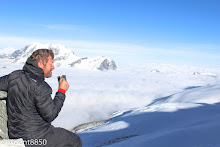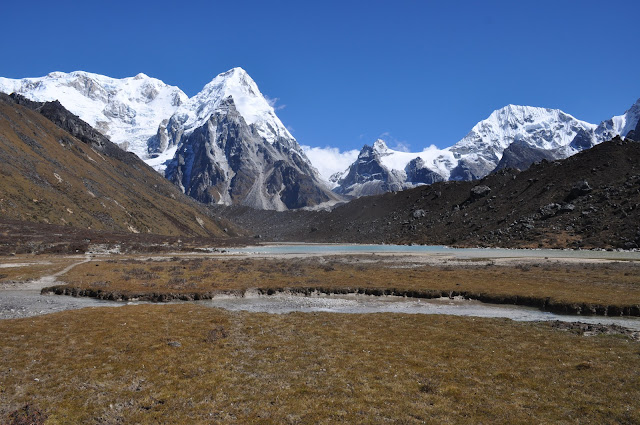The Lumba Sumba Trek is a new trekking route running through Kanchenjunga and Makalu Conservation Area in the eastern Himalaya region, in which Lumba Sumba Peak (5200m) is the major attraction. Lumba Sumba trek offers the most spectacular Himalayan landscapes, the route encompasses alpine grass lands, rocky outcrops, dense temperate and subtropical forests, and low river valleys. There are also a number of high mountain lakes in Olangchung Gola, and the Tamor and Arun River systems is another attraction for tourists. These two rivers are the major tributaries of the mighty Sapta Koshi River. On Lumba Sumba trek, trekkers may also come across different birds and wildlife species, including the endangered snow leopard and red panda along the route.
Apart from natural beauty, on the Lumba Sumba trek, trekkers can also explore cultural heritage including monasteries, chortens, temples, prayer walls, and any local festivals that may be taking place. The route is home to several different ethnic groups like the Limbus, Sherpas, Rai, Gurung, Magars, Newars and Tamangs. The trek. Trekkers will see the traditional farming practices of the local people along the way.
ITINERARY
Lumba Sumba Trek
DAY 1
ARRIVAL IN KATHMANDU 1340M
Arrive in Kathmandu and transfer to the hotel, which is close to a multitude of shopping centers and restaurants.
DAY 2
KATHMANDU – SUKETAR
DAY 3
TAPLEJUNG – MITLUNG 910M
The first day trek starts from Fungling, Taplejung district. The trail passes through beautiful cardamom fields and Alnus trees until Hangdewa village. On the way, there are small tea shops at Asangpati Tole, Gaigode Tole and Panisar Tole that can be used for alternative accommodation as they provide home stay facilities. From Panisar, the trek is downhill until the suspension bridge that acts as a border between Hangdewa Village and Furumbu village. A walk of 10 minutes takes us to Pawa Village for lunch.
After lunch, the trek continues along the banks of Tamor River to Mitlung – a walk of around two hours. Mitlung is our destination for the day as it has good camping sites with facilities like kitchen and dining hall.
DAY 4
MITLUNG – CHIRUWA 1250M
The trek passes along the banks of Tamor River on the second day. It is a pleasing walk until Furumbu village. From Furumbu, the trail is uphill for half an hour then descends through Ulnus and Schima Wallachian mixed forest to Siwa Bazar (950m) at Linkhim VDC. We can reach Siwa Bazaar in three hours from Mitlung.
Siwa Bazar is a good place for lunch. It is a small market with facilities like medicine store, groceries and a police station. After lunch, the trek runs along the Tamor River until Tawa Village. Tawa Village (1150m) has a small tea shop.
DAY 5
CHIRUWA – LELEP 1690M
Today the trek runs along the mighty Tamor River. At the start of the trek, there are two big stones with religious significance. The trek passes through Ulnus trees until we reach a big landslide that takes around half an hour to cross.
After a walk of two and half hours from Chiruwa through beautiful cardamom gardens, we reach Tapethok (1340m) for lunch. It is a small market with some tea shops. There is also a KCAP checkpoint at Tapethok. After lunch, it is a pleasing walk for about an hour until Pembu (1485m).
DAY 6
LELEP – ELA DANDA 2150M
After breakfast, the trek runs along the bank of Tamor River through dense forest that offers good habitat for different wildlife species. We cross a suspension bridge after a walk of about an hour from Lelep then it is an uphill climb through pine forest for about half an hour until we reach a monastery. From there, the trek gradually descends after about half an hour and we reach Gowatar (1800m) for lunch. Gowatar is a small settlement with a few houses. Near the village, there is a big stone and it is believed that only the religious people can move them. After a walk of around half hour from Gowatar, we reach a place that offers spectacular views of two waterfalls about 100 meters tall.
DAY 7
ELA DANDA – SELEP KHARKA 2525M
Today the walk is pleasant as it passes through Ulnus and Rhododendron forest for about an hour until we reach a suspension bridge. After crossing the suspension bridge, the trek passes through dense bamboo groves. This place is popular among trekkers as it is the habitat of the red panda. If you are lucky, we might catch a sight of the red panda!
We reach Maguwa (2435m) for lunch. After lunch, the trail passes through maple and Ulnus forest. There is a big landslide on the way before we reach Selep Kharka(3210m).
DAY 8
SELEP KHARKA – OLANGCHUNG GOLA 3210M
Today we trek along the banks of Tamor River leading to a place called Jongim, a flat land surrounded by snow capped hills. After a walk of about 2hrs, we reach a suspension bridge. Then we climb uphill from the suspension bridge and reach Ramite (2685m) for lunch. We continue the ascending walk, then we catch the first glimpse of Olangchung Gola from the waterfall. After a climb of about 40 minutes, we finally reach the camping site.
Olangchung Gola is a beautiful Sherpa village with around 45 houses, a 465 years old monastery with a golden manuscript and KCAP office.
DAY 9
TREK OLANGCHUNG GOLA – UPPER LANGMALE KHARKA 3890M
The trek from today onwards will pass through complete wilderness. The trek passes through pine and rhododendron forests. After a walk of two and half hours, we reach a place called Jadak (3630m) for lunch. Then we walk of other valley towards Lumba Samba three hours on rhododendron and mixed forests take us to our camping site at Upper Langmale.
DAY 10
UPPER LANGMALE KHARKA – PASS CAMP 4750M
The trek can be interesting today as snow leopards have been sighted numerous times from this trek. The trek runs along the small river side lies dense rhododendron forest. After a walk of about three hours, we reach Tangchetar (4200m) for lunch
DAY 11
This would be the most difficult yet most memorable day of this trek. Today the trek will pass through the Lumba Sumba Pass (5200m). It is better to start early as it will be difficult to cross the pass after noon. After a walk of about four and half hour from Pass Camp, we reach the Lumba Sumba Pass which offers panoramic Himalayan views of eastern Nepal including Kanchenjunga, Jannu himal and Makalu ranges.
DAY 12
YAK KHARKA – THUDAM 3500M
The trek is downhill from Yakkharka as we arrive to civilization after tiring walk for three days. A walk of about 6 hours takes us to Thudam for village. Thudam is a small isolated village with around 30 houses of Sherpa people.
DAY 13
THUDAM – KHARKA 2875M
Today the trek runs along the bank of Chujung Khola. The trail offers panoramic view of peaks in the Makalu range. On the way, you will see a lot of small bushes and bamboo groves – the best habitat for the red panda. After walking through many up and downs we reach to Kharka for the camp tonight.
DAY 14
KHARKA – CHYAMTHANG 2230M
The trail passes through dense rhododendron forest. As there are no villages on the way and also there are numerous side trails. After a walk of about three hours from Kharka, we reach a place called Chaurikharka for lunch. From Chaurikharka, we can clearly see Chyamtang, Arun River. After lunch, the trail heads downhill for about three hours until we reach Arun River. After crossing the suspension bridge over the Arun, the trek is uphill for about an hour until Chyamthang.
DAY 15
CHYAMTHANG – HATIYA 1516M
The trail passes through rhododendron forest from Chyamthang takes us to Gimber Village for lunch. Gimber Village offers spectacular view of snowcapped peaks in the Makalu range. From Gimber, the walk is easy and after a trek of about three hours we reach Hatiya for the night’s stay. Hatiya – a small village of Bhote people.
DAY 16
HATIYA – GOLA 1410M
The trek runs along the banks of Arun River today. After a walk of about two and half hours from Hatiya, we reach the confluence of Arun and Barun rivers. After having lunch near the river confluence, the trek progress toward Gola – our destination for the day.
DAY 17
GOLA – GHADI 1800M
The trek passes through paddy fields that we are at lowlands now. The walk is pleasing as the trail makes a short descent, but again makes a short climb. After a walk of about two and half hours from Gola, we reach Pathibhara for lunch. The trail after lunch passes through agricultural land and we can find plenty of water sources and small settlements along the way. We reach Gadhi for our destination of the day.
DAY 18
GHADI – NUM
This is the last day of our trek. From Gadhi, the trek is about an hour downhill till the Arun River. After crossing the river, an uphill climb of about 2 hour takes us to the Num village. As Num is linked with a road, we will take a jeep to Tumlingtar. A drive of around 4 hours on dirt road takes us to Tumlingtar where there is an airstrip.
DAY 19
TUMLINGTAR – KATHMANDU
After breakfast we fly back to Kathmandu along with beautiful memories of Lumba Sumba trek.
DAY 20
DEPARTURE
On the final departure our office staff will drop you at the international airport. If your flight time is in the evening or afternoon we can arrange sightseeing in the Kathmandu Valley (Pashupatinath, Monkey Temple, Boudhanath Stupa etc) at an extra cost.
INCLUDES / EXCLUDES
Lumba Sumba Trek
Package Includes
- Breakfast, Lunch, Dinner according to available menu.
- Hot water, Coffee, Snickers, Fruits
- Accommodation in a teahouse or tent
- Well experienced mountain guide and Climbing gears
- Flight Tickets Kathmandu – Suketar
- National park entry permits and other permits
- First aid kit and satellite phone.
Package Excludes
- Alcohol, Cigarettes, and other personal expenses
- Travel, accidental/ health insurance (mandatory).
- International airfare and airport tax, Visa fee Guides/ Porter’s tip.
- Emergency evacuation
Suggest Backpack
- Personal belongings (i.e.camera, water bottle, extra money, sunscreen, sunglasses, sunhat, hiking shorts/ synthetic T-shirt, etc).
- Hiking boots, sports shoes/ trainers, 3/4 woolen socks,2pairs liners socks, 1 pair of gloves, a warm hat, 1 Day backpack, and a duffel bag for your clothing.
- Warm layers, down or synthetic jackets, fleece, hiking pants, thermals.
- A comprehensive list will be provided after you book the trip.
- Most of the items can be bought or hired in Kathmandu.
 |
| https://mountadventureholidays.com/package/lumba-sumba-trek |
 |
| https://mountadventureholidays.com/package/lumba-sumba-trek |
 |
| https://mountadventureholidays.com/package/lumba-sumba-trek |
 |
| https://mountadventureholidays.com/package/lumba-sumba-trek |
 |
| https://mountadventureholidays.com/package/lumba-sumba-trek |
 |
| https://mountadventureholidays.com/package/lumba-sumba-trek |
 |
| https://mountadventureholidays.com/package/lumba-sumba-trek |





















